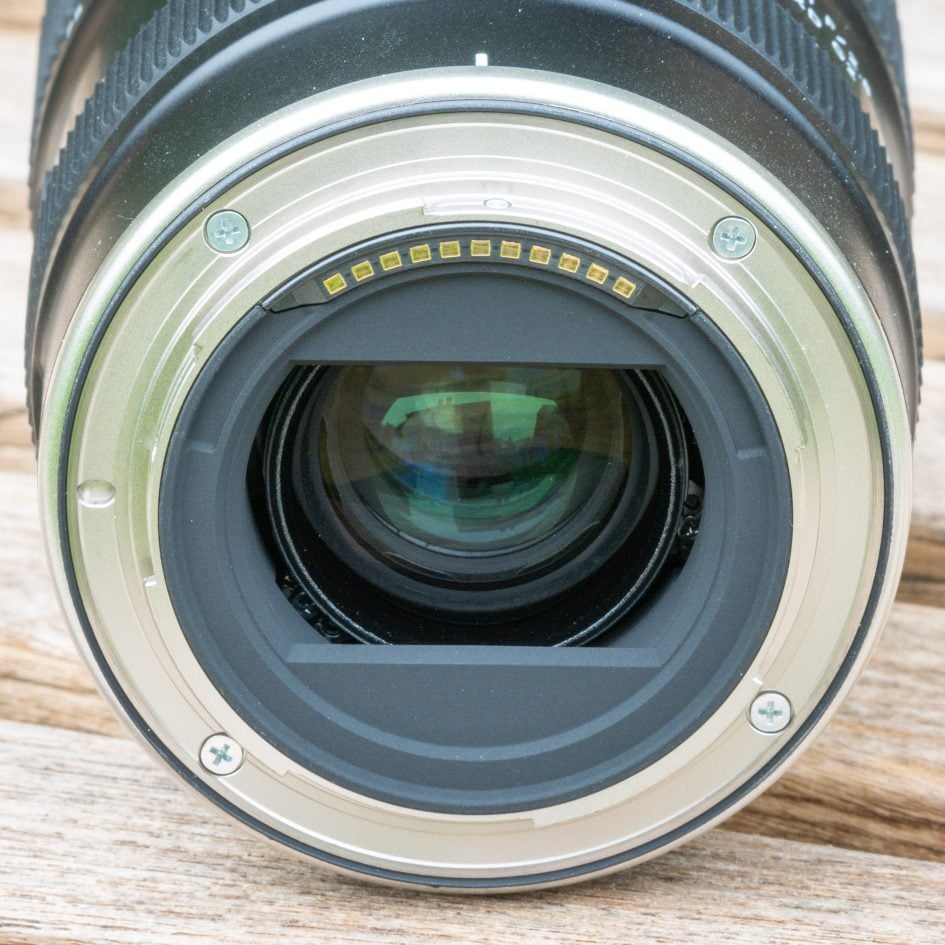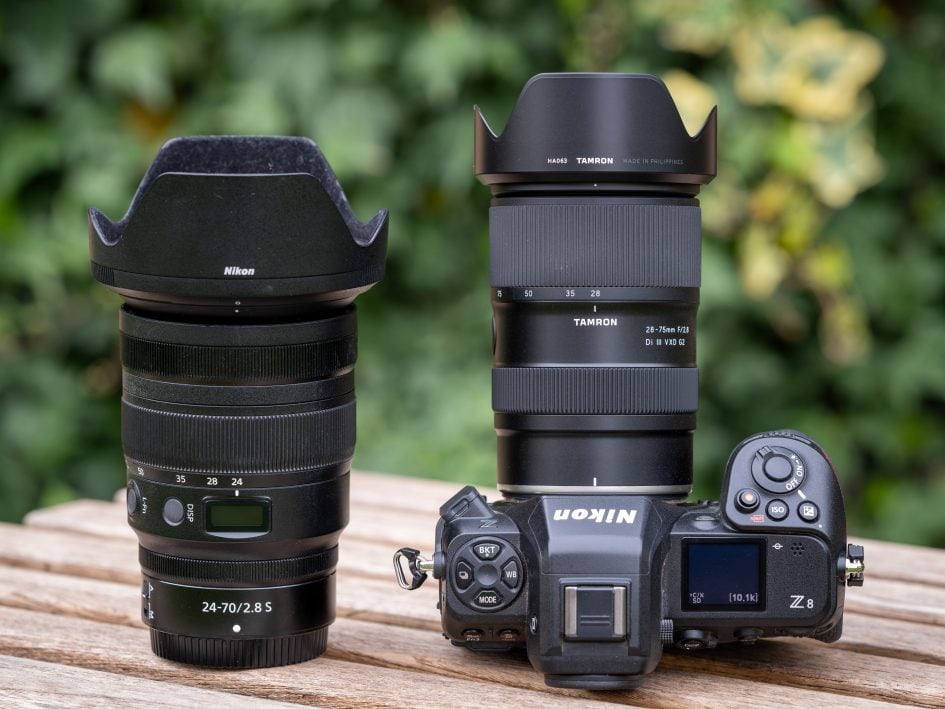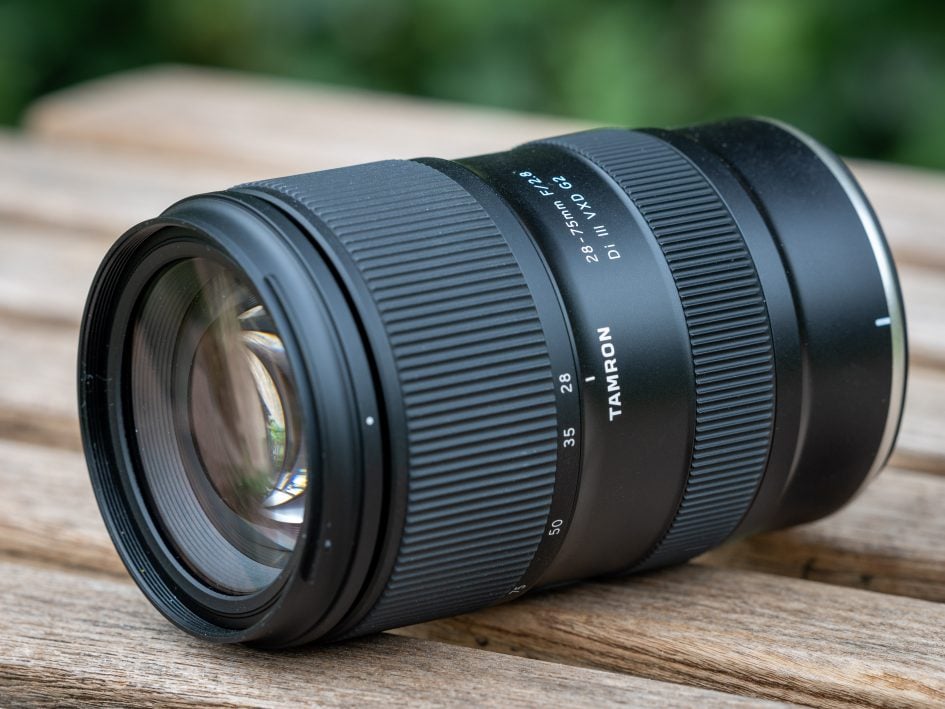Tamron 28-75mm f2.8 Nikon Z review
-
-
Written by Thomas
Intro
In 2021 Tamron introduced the 28-75mm f2.8 Di III G2 (model A063S), the 2nd generation version of their first native lens designed specifically for Sony’s full-frame mirrorless E-mount bodies. They updated the optical formula of the lens, changed the type of focus drive, and added a focus set button plus USB-C port to make the lens configurable via computer and Tamron’s Lens Utility (“TLU”). I tested the lens on a Sony A7R II and it rightfully earned a Highly Recommended in my Tamron 28-75mm f2.8 Di III G2 review. A few months later Nikon introduced the Z 28-75mm f2.8 which is based on the optical formula of Tamron’s 1st generation lens and many wondered why Nikon did not adopt Tamron’s improved G2 design. Now you can finally put the G2 optics on your Nikon Z camera as Tamron released their 28-75mm f2.8 Di III VXD G2 for Nikon Z-mount (model A063Z).
The lens is made in Japan. At 949 EUR / 999 USD / 849 GBP it is similarly priced to Nikon’s Z 28-75mm f2.8 which makes it less than half as expensive as the Z 24-70mm f2.8 S. So if Tamron’s 28-75mm f2.8 Di III G2 for Z-mount can repeat the convincing performance of the E-mount version it would certainly become a very attractive alternative to Nikon’s professional standard zoom lens. To find out I tested the lens on a Nikon Z8 and had a very close look at its optical qualities – using the newly introduced pixel shift shooting on the Z8 which quadruples the resolution of the camera to 180MP.
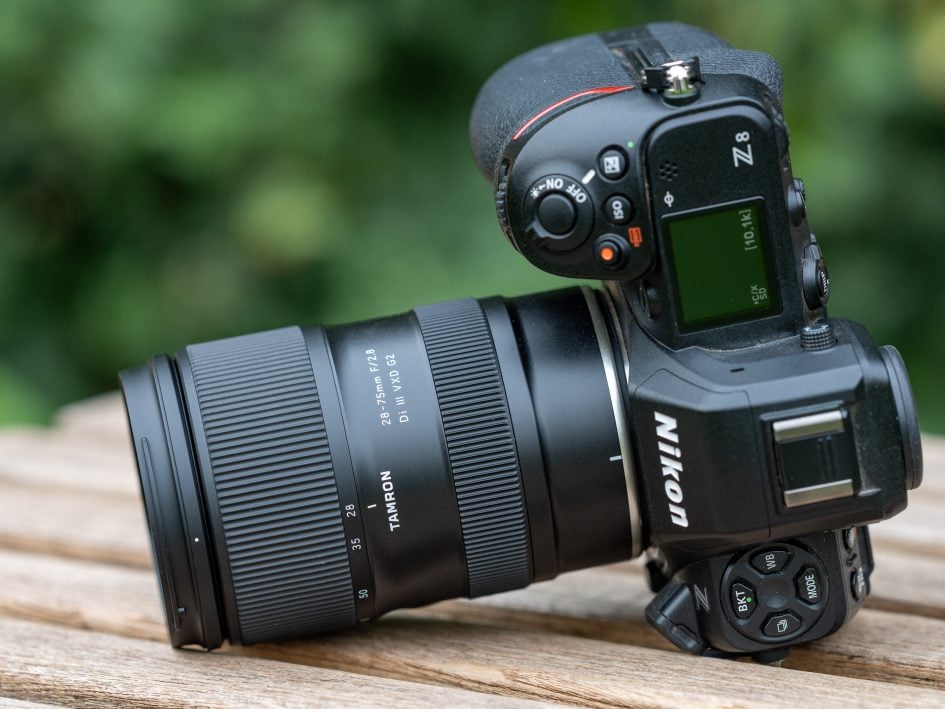
Facts and features
Let’s compare the Tamron 28-75mm f2.8 Di III G2 for Z-mount (“Tamron” for short) to the Nikon Z 24-70mm f2.8 S and Nikon Z 28-75mm f2.8. As usual I’ve rated the features with a [+] (or [++]), when it’s better than average or even state of the art, a [0] if it’s standard or just average, and [-] if there’s a disadvantage.
Size (diameter x length): at 76 x 120mm (3.0 x 4.7in.) plus 28mm for the lens hood (87mm diameter) the Tamron is as compact as the Nikon Z 28-75mm f2.8 at 75 x 121mm + 37mm lens hood. The Nikon Z 24-70mm f2.8 S measures 89 x 126mm + 41mm lens hood. All lenses extend when zoomed to their longest focal length: The Tamron extends by 18mm, the Nikon Z 24-70mm f2.8 S by 30mm, the Nikon Z 28-75mm f2.8 by 25mm. [+]
Weight: at 550g (1.2 lb.) plus 27g for the lens hood the Tamron is even lighter than the Nikon Z 28-75mm f2.8 at 565g + 25g lens hood. The Nikon Z 24-70mm f2.8 S is 803g + 43g lens hood. [+]
Optics: The Tamron has 17 elements in 15 groups including 2 special dispersion elements and 2 aspherical elements. The Z-Nikkors are of a similarly complex construction. And all three lenses have fluorine coating at the front lens to repel water, dust, and dirt and make cleaning easier. [+]
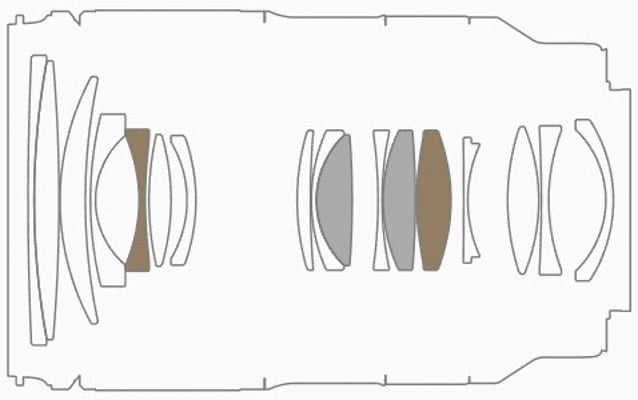
Minimum object distance is 0.18m (7.1in.) with a magnification of 1:2.5 and an extremely short working distance of 4cm (1.6in.) at 28mm focal length. At 75mm focal length maximum magnification is 1:3.7 which is still quite good and results in a better working distance of around 22cm (0.7ft.). A magnification of 1:10 is achieved at 75mm focal length at 0.85m (2.8ft.) distance. The Nikon Z 24-70mm f2.8 S achieves its maximum magnification of 1:4.2 at 70mm focal length, the Z 28-75mm f2.8 achieves 1:2.9 at 28mm focal length and 1:3.4 at 75mm. [+]
Filter-thread: Both the Tamron and Nikon Z 28-75mm f2.8 take 67mm filters. The Nikon Z 24-70mm f2.8 S needs 82mm filters. [+]
Image stabilization: None of the lenses in this comparison has optical image stabilization. But the full-frame Nikon Z camera bodies have sensor-based image stabilization built in. [0]
Autofocus: All lenses in this comparison offer autofocus with built-in focus drive. Manual-focus override is by simply turning the dedicated focus ring. The action of the focus ring on the Tamron can be switched from the camera between the usual variable gearing or linear gearing and the direction of the ring can be reversed. That’s the same as with the Z-Nikkors. [+]
All lenses in this comparison cover full frame sensors or can equally be used on a cropped DX camera body with Z-mount. On a cropped sensor the angle of view of the Tamron is equivalent to a 42-113mm zoom lens. [+]
Price: The Tamron 28-75mm f2.8 Di III G2 for Z-mount comes at a recommended retail price of 949 EUR (incl. 19% VAT) / 999 USD / 849 GBP. Btw: The version for Sony E-mount started at the same prices in 2021 and currently sells for 750 EUR / 899 USD / 750 GBP. The Nikon Z 24-70mm f2.8 S is around 2300 EUR / 2400 USD / 2200 GBP, the Z 28-75mm f2.8 currently sells for 950 EUR / 997 USD / 890 GBP. [+]
The Tamron comes without a pouch but the reversible lens hood is included. The Z-Nikkors come with a lens hood and a flimsy pouch. Only the lens hood of the Nikon Z 24-70mm f2.8 S has a lock to prevent it from accidentally falling off. [0]
Aperture ring and other control elements: None of the lenses in this comparison has a dedicated aperture ring. But you can assign the focus set button on the Tamron to switch the focus ring to operate the aperture. You can also assign other functions to the focus set button apart from the usual focus preset e. g. make the focus automatically shift between two focus positions A and B or assign a function from the camera body. Some of these functions can be set from the camera (menu f2: Custom controls) but for others you need Tamron’s Lens Utility (TLU) and connect the lens to a computer or smartphone via USB-C cable. This is also the way to update the firmware of the lens. On the Z-Nikkors the multi-function control ring can be assigned to operate the aperture, exposure compensation, ISO sensitivity, or focus (on the Z 28-75mm f2.8; the Z 24-70mm f2.8 S has a dedicated focus ring) – or simply switched off. The Z 24-70mm f2.8 S also has a function button which normally operates as a focus lock button but can be assigned other functions from the camera. [+]
Sealing: All lenses in this comparison have a rubber grommet at the lens-mount plus further special weather-sealing throughout the construction. [+]
At a score of 0[-]/2[0]/10[+] the Tamron 28-75mm f2.8 Di III G2 is a well featured design with its major advantages being small and light, and coming at a very reasonable price. And Tamron did not skimp on features like thorough weather sealing, focus set button, and customization via USB port. Plus it can reach magnifications of 1:2.5 – albeit at a very short working distance. The only really critical point may be that the zoom starts at 28mm which gives a 9 degrees narrower angle of view than lenses starting at 24mm.
Two standard zoom lenses
Above: Nikon Z 24-70mm f2.8 S (left), Tamron 28-75mm f2.8 Di III G2 (right)
Coverage
With its 2.7x zoom-range the Tamron starts at the short end with an angle of view of 75 degrees, compared to the 84 degrees of zooms starting at 24mm. At the long end 75mm offer 7% more reach/magnification than 70mm.
Here is the angle of view that the Tamron 28-75mm f2.8 Di III G2 covers compared to the Nikon Z 24-70mm f2.8 S (Distortion control set to On):
Above: Tamron 28-75mm f2.8 Di III G2 coverage on a full-frame camera at 28mm (left) and 75mm (right)
Above: Nikon Z 24-70mm f2.8 S coverage on a full-frame camera at 24mm (left) and 70mm (right)
The difference between a zoom lens starting at 28mm versus a lens starting at 24mm is visible but doesn’t look like much. I wouldn’t underestimate the difference at the short end though: Not always can you step back enough to get the almost 10 degrees wider view of 24mm focal length. The other thing of note: The benefit of reaching 75mm is certainly not a decisive factor. If the image at 70mm is sharp enough, cropping a 45MP shot at 70mm to match the angle-of-view of 75mm still nets you around 39MP.
Focus and zoom
Focus accuracy and repeatability is critical to consistently produce sharp shots. Repeatability (the accuracy of focus on the same subject after repeated focus-acquisition) of the Tamron 28-75mm f2.8 Di III G2 is not so good: Reikan FoCal measured only 94% consistency influenced by two clear outliers over a series of 40 shots on the well lit and contrasty focus test target. For comparison: The Nikon Z 24-70mm f2.8 S achieved 98% consistency with no outliers under the exact same test conditions. I repeated both tests and got the same results. The Tamron also showed some focus variation whether the lens focuses from a closer distance or from infinity: The outliers happened when the lens came from a closer distance. Fortunately the outliers were so obviously out-of-focus that you could immediately recognize them in the viewfinder. That’s much better than near-misses where you think focus is perfect only to find out later that it was not. Without the outliers focus consistency of the Tamron was pretty good although still not quite as good as from the Nikon Z 24-70mm f2.8 S. On a Z8 and at 75mm focal length the lens focuses in around 0.3 sec from infinity to 0.85m (1:10 magnification) which is very fast and comparable to the Nikon Z 24-70mm f2.8 S. The Nikon Z 28-75mm f2.8 is clearly slower.
The zoom ring has a pretty short throw of about 60 degrees and turns the way Nikon users are used to. It has a 28mm wide rubber surface with a good grip and turns with quite some resistance. It can hardly be operated with one finger and shows no zoom creep – at least fresh out of factory. The focus ring is 16mm wide and is located closer to the camera. It also has a rubberized surface, moves smoothly, and can easily be operated even with your pinky.
In photo mode AF-operation is almost inaudible from the outside. If you record video with the built-in microphone the AF-drive is quiet, only turning the zoom ring registers as a slight friction noise. When the lens is powered down the focus group inside the lens slides back and forth freely as the focus drive is not engaged. That makes a low thunking sound and you can feel the focus group moving around.
As you pull focus, you’ll notice very little focus breathing: The image became 1.5% more magnified when I adjusted focus from infinity to 0.85m at 75mm focal length. The same test at 28mm focal length produced a 0.4% increase in magnification.
I also tested whether Tamron’s zoom lens allows you to change the focal length without altering its focus. This characteristic is called parfocal. I focused the lens at 75mm and then slowly zoomed back checking focus on the way. The 28-75mm f2.8 Di III G2 kept its focus perfectly over the complete zoom-range.
Next check out my quality results!
Check prices on the Tamron 28-75mm f2.8 for Nikon Z at B&H, Adorama, WEX UK or Calumet.de. Alternatively get yourself a copy of my In Camera book, an official Cameralabs T-shirt or mug, or treat me to a coffee! Thanks!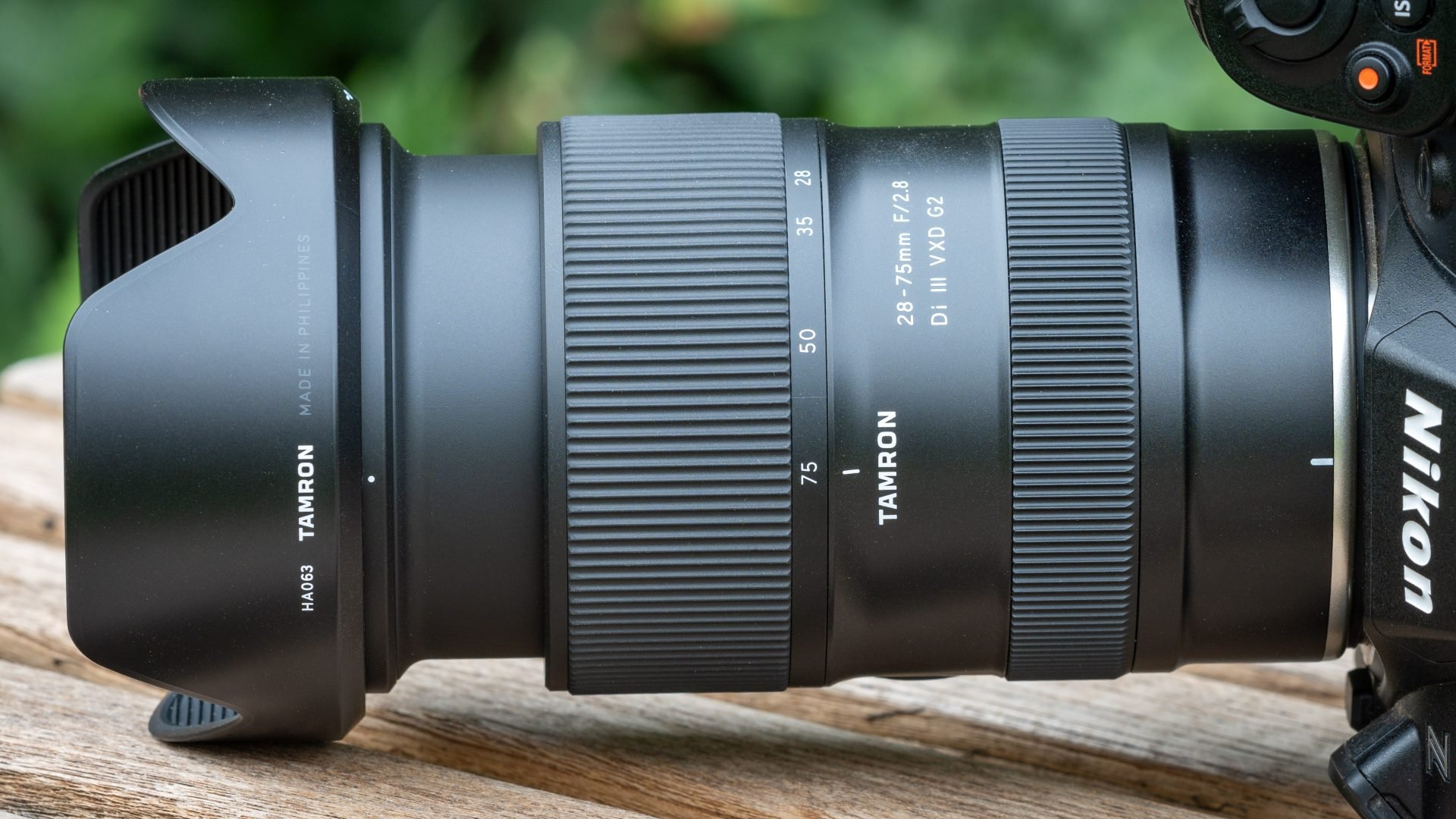
 Tamron's 28-75mm f2.8 Di III G2 is optically right up there with the best from other manufacturers. Plus, it's small and lightweight and attractively priced. And Tamron didn't skimp on features: The lens is fully weather sealed and has a focus set button plus USB-C port to make the lens highly configurable via computer and their Lens Utility software. Only its close-up performance is disappointing - and you might ponder whether 28mm is wide enough for your purposes. But other than that Tamron has designed a compelling standard zoom with an attractive price-performance ratio which clearly earns a Highly Recommended!
Tamron's 28-75mm f2.8 Di III G2 is optically right up there with the best from other manufacturers. Plus, it's small and lightweight and attractively priced. And Tamron didn't skimp on features: The lens is fully weather sealed and has a focus set button plus USB-C port to make the lens highly configurable via computer and their Lens Utility software. Only its close-up performance is disappointing - and you might ponder whether 28mm is wide enough for your purposes. But other than that Tamron has designed a compelling standard zoom with an attractive price-performance ratio which clearly earns a Highly Recommended!